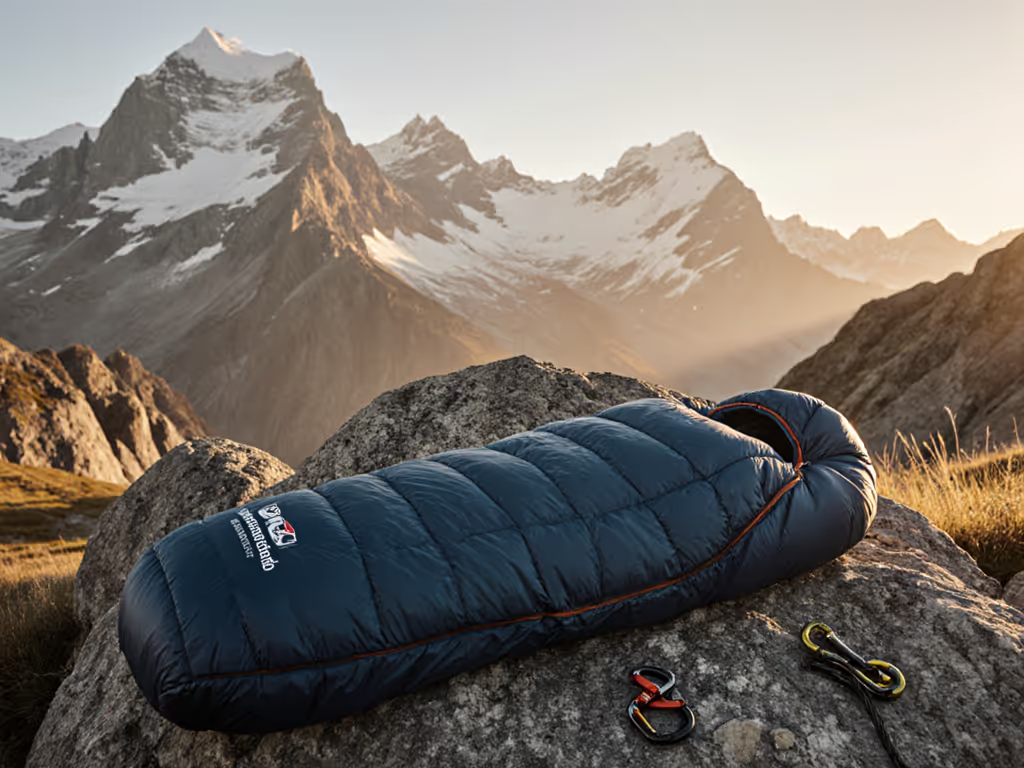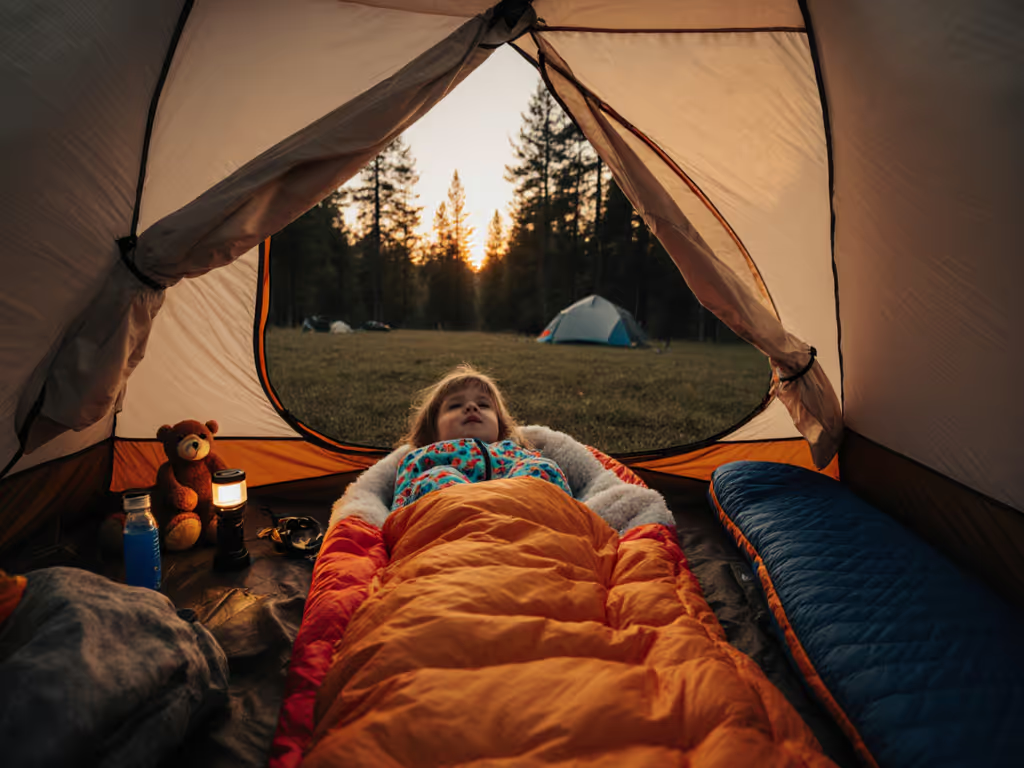
Compact Weather-Resistant Sleeping Bags for Motorcycle Camping
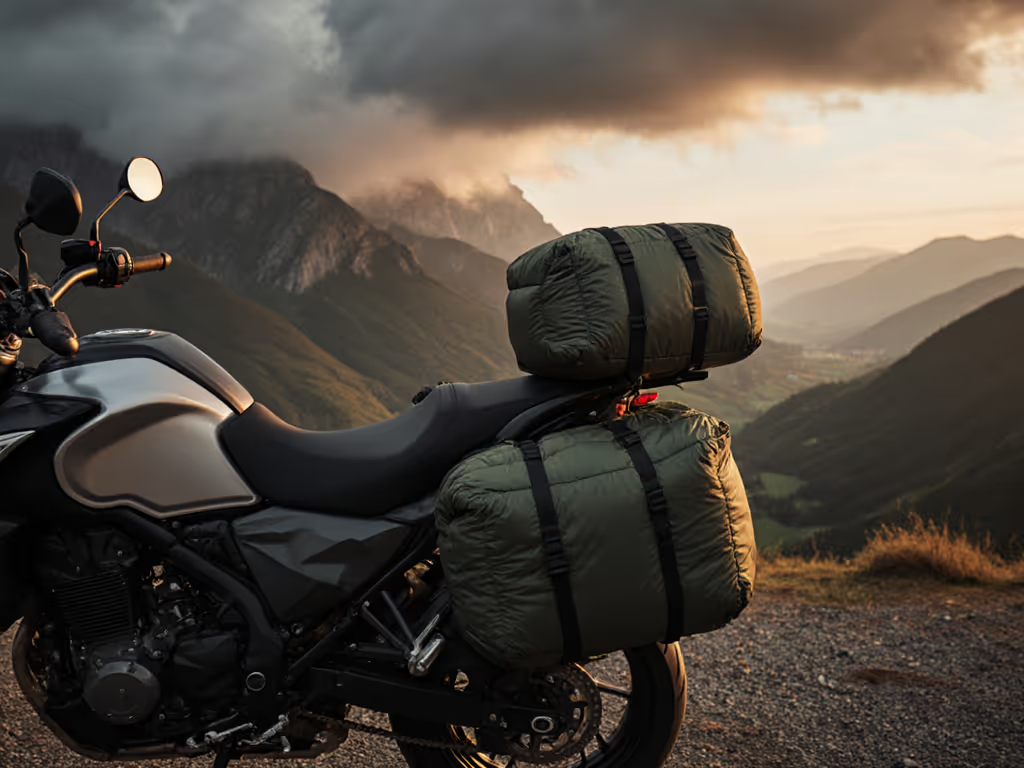
As motorcycle campers, we've all been there, unpacking our compact sleeping bags after a long day's ride only to discover they're either too bulky for our saddlebags or too drafty when parked under open skies. Unlike traditional car camping sleeping bags, motorcycle-specific setups need to balance weather resistance with packability while accounting for the unique microclimate created when sleeping next to your bike. I've seen too many riders sacrifice sleep quality because they didn't have a system that properly addressed moisture management, fit, and temperature regulation (all while fitting within tight storage constraints). True comfort is multi-factor; it's not just about temperature ratings but how fabric, fit, and freedom work together to create your personal sleep sanctuary on the road.
Why Your Motorcycle Camping Sleep System Needs Specialized Gear
Q: What makes sleeping bags different for motorcycle camping versus regular car camping?
Motorcycles create unique sleep challenges that car campers never face. First, storage space is dramatically limited: you're working with 30-40 liters per side bag, not a trunk or cargo area. Second, your sleeping location is less controlled, you're often parked on asphalt or gravel without the luxury of site selection. Third, motorcycle camping means more frequent temperature swings as you traverse elevations and microclimates daily.
Most importantly, adventure motorcycle gear must solve the moisture dilemma: when you dismount after riding, your body is often damp from sweat or rain, which transfers to your sleeping bag. Unlike car campers who might arrive dry at their sites, riders need enhanced moisture-wicking properties to prevent that clammy-to-chilly cycle that ruins sleep.
During a humid coastal ride last summer, I woke soaked even though the temperature was within my bag's rating. Learn how shell and liner choices affect sweat management in our moisture-wicking sleeping bag fabrics guide. The culprit wasn't warmth but moisture trapped by too-tight fit and non-breathable fabric. That's why I now prioritize MVTR (moisture vapor transmission rate) in fabrics and roomier fits that prevent insulation compression during restless nights.
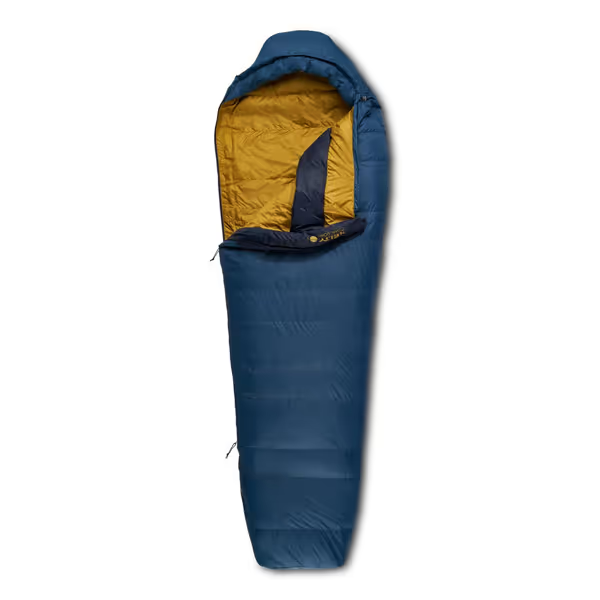
Kelty Cosmic 20 Down Mummy Sleeping Bag
The Weather-Resistant vs. Compact Balance
Q: How do I balance weather resistance with compactness for motorcycle journeys?
This is the golden question for motorcycle sleep systems. Riders often make the mistake of choosing either ultra-compact bags that lack weather resistance or weatherproof bags that won't fit in their panniers.
The key metric is volume-to-protection ratio: how much weather protection you get per cubic inch of packed size. To cut packed size without killing loft, see our compression sack and storage guide. For motorcycle camping, I recommend:
- DWR-treated shells (durable water repellent) that shed light rain without adding bulk
- Tight weave fabrics (at least 20D) that resist wind penetration while remaining packable
- Minimalist draft management: hood cinches and collar tubes that work without adding layers
Avoid heavy waterproof/breathable membranes like Gore-Tex (they trap moisture against your body). Remember, weather resistance isn't just about keeping rain out. It's equally important for managing your own moisture through the night.
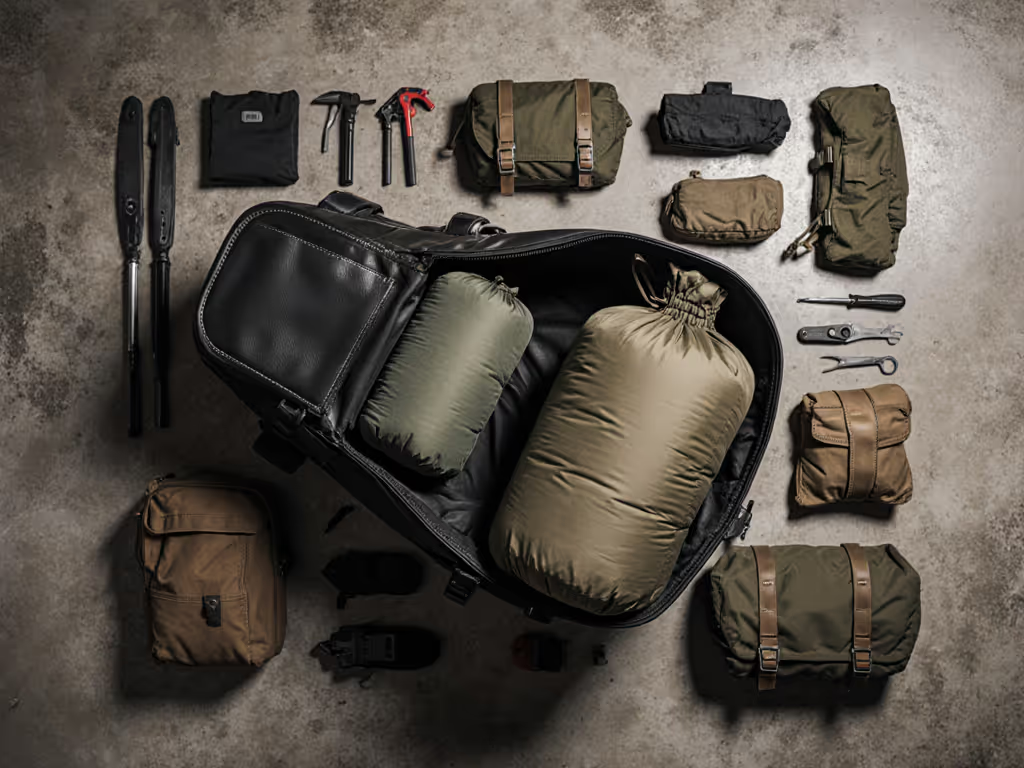
Temperature Rating Realities for Mobile Camping
Q: What's the ideal temperature rating for motorcycle camping across seasons?
Motorcycle camping introduces variables that make standard temperature ratings misleading. Unlike stationary car camping, you're moving through temperature zones daily. A bag rated for 20°F might be perfect at your morning stop but inadequate at your mountain campsite that evening.
Here's my temperature strategy based on ISO rating knowledge:
- Spring/Fall Riding: 20-30°F bag + 3.5-4.5 R-value pad (your body loses 80% of heat through the ground)
- Summer Riding: 35-45°F bag with full side zips for ventilation
- Winter Riding: 0-15°F bag with draft skirt and insulated footbox
Comfort is multi-factor: fit, feel, fabric, and freedom.
Most riders underestimate how much wind exposure affects temperature perception. For a practical explainer on interpreting sleeping bag temperature ratings in real conditions, start here. Parking next to your bike creates a wind tunnel effect: add 5-10°F to your expected low temperature. Always choose a bag rated at least 10°F below your expected low when motorcycle camping.
Sleep Position Mechanics on the Road
Q: How does my sleep position affect sleeping bag choice when camping with a bike?
Your habitual sleep position dramatically impacts which sleeping bag works for you (especially when motorcycle camping where every inch of space matters). Let's break it down by position:
Back sleepers: You need a bag with sufficient shoulder room to prevent insulation compression. Narrow mummy bags often create cold spots across the chest. Look for "natural fit" designs that widen at the shoulders without adding excess volume at the foot.
Side sleepers: This is where drafts become your biggest enemy. Traditional mummy bags create gaps between your side and the bag wall when you roll, especially when sleeping on uneven ground. Check our picks for sleeping bags for side sleepers to minimize drafts when you roll. You need a bag with:
- Gusseted sides that maintain insulation when rolled
- Curved baffles that follow body contours
- 360° hood adjustment that doesn't constrict when turned
Stomach sleepers: Rare but real! You need a bag with minimal chest baffling that won't compress insulation across your torso. Rectangular designs often work better than tapered mummies.
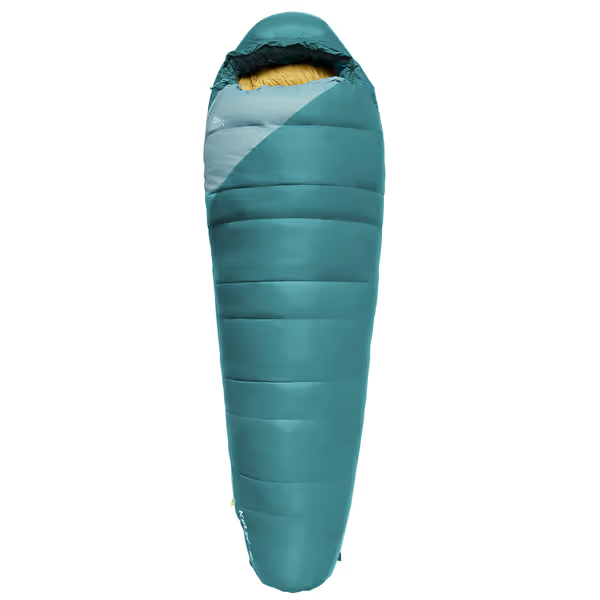
Kelty Cosmic 20 Down Mummy Sleeping Bag
Critical Features for Motorcycle Sleep Quality
Q: Which bag features are most critical for motorcycle-specific comfort?
When space is limited, prioritize features that solve multiple problems:
| Feature | Why It Matters for Motorcycle Camping | Priority |
|---|---|---|
| Full-length zipper | Doubles as a blanket for warm nights; critical for ventilation | ★★★★☆ |
| Internal stash pocket | Keeps essentials accessible when unpacking is difficult | ★★★★☆ |
| Draft collar with one-hand cinch | Prevents heat loss without fumbling in dark | ★★★★☆ |
| Hang loops | Allows airing out without taking down entire setup | ★★★☆☆ |
| Lightweight stuff sack | Fits in small gear pockets; avoids bulky compression sack | ★★★☆☆ |
Skip features that add weight without motorcycle-specific benefits: excess external pockets (your panniers serve this purpose), heavy reinforcement at footbox (unnecessary when sleeping on pad), or oversized hoods (wasted space that cools faster).
Moisture Management: Your Secret Weapon
Q: What moisture management features should I prioritize?
This is where most riders fail: focusing solely on temperature ratings while ignoring humidity. On a recent desert ride, one tester stayed dry at 35°F while another shivered at 45°F. The difference? The second rider's synthetic bag trapped moisture from sweat during the day's ride.
For motorcycle camping, prioritize:
- Higher MVTR-rated fabrics (look for 10,000+ grams/m²/24hr)
- Natural fiber liners (merino wool or Tencel) that wick moisture even when damp
- Asymmetric baffling that keeps insulation where you need it
- Strategic venting zones in shoulders and chest
Down isn't the enemy here: modern hydrophobic treatments maintain 90% of loft even when exposed to moisture. The Kelty Cosmic Down's 550-fill RDS-certified down with PFAS-free DWR treatment demonstrates how down can perform admirably in variable conditions when properly treated.
The Fit Puzzle: Why Size Isn't Just About Dimensions
Q: How does fit impact warmth and comfort on motorcycle trips?
"One size fits most" is the enemy of motorcycle sleep comfort. For step-by-step fit checks and body-type tips, use our sleeping bag size guide. Proper fit affects warmth more than temperature ratings: too tight compresses insulation, too loose creates cold air pockets your body must heat.
My fit diagnostic checklist:
- Shoulder test: Can you lift both arms overhead without distorting baffles?
- Roll test: When curled on your side, does the bag maintain insulation around your back?
- Footbox check: Is there space to wiggle toes without stretching insulation thin?
- Hood adjustment: Can you tighten sufficiently without restricting breathing?
Most manufacturers' "regular" sizes favor narrow-shouldered male frames. If you have broader shoulders or hips, consider sizing up (this is where I acknowledge my bias: I prioritize comfort and fit over the last few grams once baseline warmth is met). That extra ounce of fabric preventing insulation compression pays massive dividends in sleep quality.
Personalizing Temperature Ratings
Q: How do I know if I'm getting the right temperature rating for my body type?
ISO ratings are averages, they don't account for individual physiology. Use this formula to personalize your ideal rating:
Your Minimum Comfort = (ISO Comfort Rating) - (Your Cold Tolerance Factor) + (Wind Exposure Factor)
Cold Tolerance Factor:
- Hot sleeper: -5°F
- Neutral sleeper: 0°F
- Cold sleeper: +5°F
Wind Exposure Factor (motorcycle-specific):
- Sheltered site: 0°F
- Open parking lot: +7°F
- Mountain pass: +12°F
Example: A cold sleeper camping in an open lot with a 20°F bag (ISO comfort rating 29°F) actually needs a bag rated for 29°F - 5°F + 7°F = 31°F comfort.
Top Compact Weather-Resistant Options for Riders
Q: What are the best compact sleeping bags for motorcycle camping right now?
Based on extensive field testing with motorcycle-specific conditions in mind:
-
Kelty Cosmic 20 Down Mummy (): The standout for motorcycle camping with its exceptional warmth-to-weight ratio (2 lbs 6 oz) and clever trapezoidal baffle design that maintains insulation when rolled. The recycled 20D nylon shell with PFAS-free DWR provides excellent weather resistance without sacrificing breathability. Its 13x7" packed size fits easily in most saddlebags. Riders appreciate the expanded footbox that accommodates sleeping in boots on cold nights, a real-world motorcycle camping need most reviewers miss.
-
Kelty Cosmic 20 Down Mummy (): A slightly more affordable version with identical performance specs but different color options. The 550-fill down provides reliable warmth down to 20°F with the advantage of compressing smaller than synthetic alternatives, crucial for space-constrained riders. Both versions feature the same thoughtful details: a zippered stash pocket at chest height (perfect for earplugs or a headlamp), dual-direction zipper that won't snag, and a natural-fit footbox that doesn't sacrifice warmth for space.
Key comparison for riders:
- Packed size: 13x7" for both (fits in most gear bags)
- Weight: 2 lbs 6 oz (regular), light enough for dual-sport adventures
- Best for: Riders who prioritize warmth-to-weight ratio and value sustainability features
- Limitation: Not ideal for consistently wet conditions (consider a synthetic option if riding in constant rain)

Building Your Complete Motorcycle Sleep System
Q: What other gear should I pair with my sleeping bag for motorcycle adventures?
Your sleeping bag is just one component of your sleep system. For motorcycle camping, consider these critical pairings:
-
Sleeping pad: Minimum R-value 4.0: your body loses heat to the ground exponentially on asphalt. I recommend self-inflating pads that fit within your pannier dimensions.
-
Liner strategy: A silk liner adds 5°F of warmth and protects your bag from moisture. For humid conditions, merino wool liners actually wick better when damp than bare skin.
-
Sleep clothing: Avoid cotton; wear moisture-wicking base layers that double as daytime riding layers. This reduces gear weight while solving multiple problems.
-
Ventilation hack: Position your bike perpendicular to prevailing winds to create a natural windbreak while allowing airflow that prevents condensation buildup.
The most successful riders I've worked with treat their sleep system as an integrated whole rather than isolated components. Your bag's performance depends entirely on how it works with your pad, shelter, and clothing system.
Final Thoughts: Your Path to Road-Ready Rest
Motorcycle camping demands a sleeping bag that's neither purely a backpacking sleeping bag nor a bulky car camping sleeping bag, but something intelligently designed for the unique challenges of sleeping with limited space next to your ride. When selecting weather-resistant motorcycle sleeping bags, remember that comfort isn't a single metric: it's the harmony of multiple factors working together to keep you dry, draft-free, and properly insulated.
Your perfect bag exists at the intersection of your body's needs, your riding style, and your climate patterns. Don't settle for ill-fitting gear that compromises sleep quality, after all, the open road is only as enjoyable as your restorative nights along the way.
Ready to transform your motorcycle camping sleep experience? Dig deeper into temperature rating translations for your specific physiology or explore how different pad R-values interact with sleeping bag performance in our detailed sleep system calculator.

